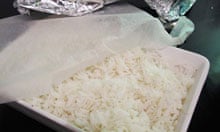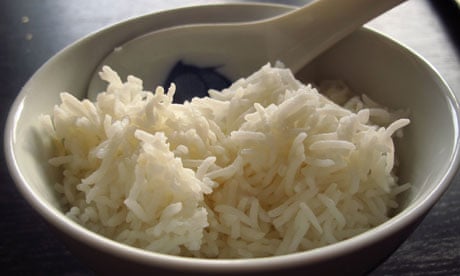Rice still has the faintly haughty air of a foreign delicacy in this country. You know where you are with pasta – there's not much more to it than there is to boiling a potato – but rice, well, it's temperamental, prone to gathering in great claggy clumps, or boiling over in a torrent of unappetising foam. We're all scared of rice – we must be, that's the only explanation I can find for the way we serve it, slopping all over the plate in a tide of starchy water, or stuck to the plate in a daunting mass of dry carbohydrate.
After all, it's not as if rice is a novelty – we've been cooking with it for far longer than spuds or spaghetti – and nor is it rare; in fact, as pub quiz aficionados will no doubt be aware, it's the world's second most popular staple crop, trailing only maize (and who in their right minds would opt for polenta over pilau if they had a choice?).
Rice is revered in many cultures, despite the common assumption amongst many of us that everyone would be tucking into bowls of mash given half the chance: as Sri Owen, the Indonesian-born author of the final word on the subject, The Rice Book explains, "Asians don't eat rice because they can't get anything else … there are often other crops which would feed them more easily and cheaply. They go to the enormous trouble of cultivating rice because, in flavour, texture and general satisfaction, no other staple food comes anywhere near it." And then we go and invent boil-in-the-bag.
Washing
Theories abound as to the best way to cook rice. Having never enjoyed much success with the microwave (scrubbing starch from electrical objects has never featured in my top 10 of recreational activities) and lacking the room for a dedicated rice cooker, it's the hob for me. But there's more than one way to skin a cat – and the disagreement here starts well before the flaying begins.
Washing the rice in several changes of water, for example, as recommended by Meena Pathak – and common in "most Asian countries" according to Owen, is unnecessary when it comes to the rice sold in the UK, which has generally been exhaustively picked over to rid it of any remaining husks and other detritus before packaging. I certainly find very little in the stuff I buy. Posters on the online messageboard chowhound.com suggest it rinses off excess starch and gives a fluffier result, but if it does, I can't tell the difference.
A good old soak?
Soaking, however, is a different matter. It's a step I'm often tempted to leave out (and it never features in packet instructions), but with the combined weight of Sri Owen, Madhur Jaffrey and Vivek Singh of the Cinnamon Club behind it, it has to be worth a try. Owen explains that it helps to soften the grains, so the water can penetrate them more easily, and thus stops them sticking together in the pan during cooking.
I try soaking basmati rice in cold water for half an hour, an hour and three hours, and then cook it and compare it to rice which hasn't been soaked at all – there's little to choose from between the three soaked grains, but it's definitely more evenly cooked, and easier to separate than the non-soaked portion, which seems dry and clumpy in comparison.
According to the instructions on the packet
I used to cook rice according to the instructions on the packet, naively trusting that they would give the best results – but when it comes to rice, it seems they're designed to be foolproof, if not perfect. My packet of brown basmati, from a well-respected name once endorsed by Madhur herself, certainly does not consult their former brand ambassador when it comes to the blurb – I've got to tip the dry rice into plenty of boiling water, and cook for 25 minutes, which gives a familiar, but slightly disappointing result. It's cooked through, sure, and the grains are nicely separated, but even after returning them to the warm pan for a couple of minutes to dry out, they're bland and ever so faintly soggy.
The absorption method
It may sound faintly like a slightly unreliable form of birth control, but this is, in fact, the most common way to cook rice in the east – rather than drowning it in water and hoping for the best, one adds only as much as the rice needs to cook, and waits for it to absorb it all. In his book Curry: Classic and Contemporary, Vivek Singh says that rice dishes cooked in this way "retain more flavour and nutrients". Obedient to Sri Owen's instructions, I put 450g rice in a pan with a pint of cold water, bring to the boil, then turn down the heat and simmer until all the water has been absorbed, by which time it is swollen, but still chalky to the bite.
She then gives four options for finishing the stuff off – the first, and most traditional, being covering the pan with a tightly fitting lid, and simmering the contents gently for 10 minutes, then leaving it to rest for another 5 before inspecting it. Putting a pan of a notoriously gluey ingredient on to the heat with no visible liquid to keep it from sticking is nerve-racking stuff, and I do indeed manage to burn the bottom a couple of times before mastering the technique. The rice itself is pleasingly fluffy, though, and otherwise perfectly cooked.
Steam power
Secondly, she suggests, you can steam your par-boiled rice. This is the method that Jamie Oliver uses, under the bold claim that it's foolproof – the partially softened rice is transferred to a colander, and steamed over the pan of boiling water until cooked through. The results are indeed good, as light and fluffy as Mr Oliver promises, but personally, I think you'd be a fool to let yourself in for so much unnecessary washing up for something so simple.
The oven

Rice can also be finished off in a buttered baking dish in the oven – 15 minutes at 180C, swaddled in buttered paper and foil, should do it. Not only does this give a slightly dryer result, but unless you've got the oven on for something else, it's an almost criminal waste of energy, and greaseproof paper.
The microwave
I give the microwave another go, swapping the pan for a plastic container, and dutifully watching it spin for 5 minutes. It doesn't boil over this time – although only because I've cheated it of the water to do so – but it doesn't seem quite as fluffy as the steamed or simmered stuff.
The finger method
Rosemary Brissenden, author of the masterful South-East Asian Food, suggests an easier way to measure your water, using only a finger; apparently no matter how much rice you use, or how large your saucepan, the water should always come up to the first finger joint, if your fingertip is just touching the rice. I try this, but end up with soggy rice, which leads me to wonder whether my digit may be at fault. To be honest, measuring out water in a jug isn't too much of a faff anyway, although it's a tip to bear in mind should you ever venture into camp cookery.
Madhur
Madhur Jaffrey is a woman who has some form in introducing exotic foodstuffs to British cooks, and in my eyes, she can do no wrong (seriously, have you ever tried her mung dal with green chillies?), so I'm interested in her variation on the absorption method. She uses about the same ratio of water to rice as Sri Owen, but employs a two, rather than three-stage process – as soon as the pan comes to the boil, she covers it, turns the heat right down, and leaves it to simmer very, very gently for 25 minutes. When, scourer at the ready, I remove the lid, I find it's absolutely perfect – fluffy, with separate grains, which, as the Indian proverb has it, are like brothers – close, but not stuck together.
Handy tips
Many writers, Brissenden included, beg the reader not to add to salt to their cooking water – "let it speak for itself" Sri Owen urges – but, western philistine that I am, I've gone back to it in the belief that a pinch helps to bring out the aromatic flavour of the rice. I do take one very useful tip from The Rice Book, however – rest your pan on a damp tea towel after cooking, and you'll get a cake of rice at the bottom, which, she says, the Indonesians call intip. She suggests drying it, and then deep-frying it as a snack, but I like it just as it is, as a cook's perk – plus, allowing the rice to stick to itself, rather than the pan, also helps with the washing up, which is a definite bonus.
As long as you get the measurements right, I guarantee the recipe below will work perfectly with all sorts of long-grained rice, leaving you plenty of time to get on with making the rest of the dinner. And if something does go wrong, console yourself with the knowledge that in rice-eating cultures around the world, from Iran to Korea, a 'burnt' crust at the bottom of the pan is eagerly fought over as a delicacy – in fact, in Puerto Rico, there are even a number of popular merengue songs devoted to singing its praises. Remember that as you're doing the washing up.
Perfect long grain rice

Serves 4
450g basmati rice
Pinch of salt
1. Give the the rice a brief rinse under running water and then put it in a large pan and cover with cold water. Leave for at least half an hour.
2. Drain the rice and discard the soaking water. Put it in a large pan containing 585ml fresh water and a generous pinch of salt on a medium heat.
3. Bring to the boil, and give it a good stir. Cover tightly and turn the heat down very low. Cook for 25 minutes (28 for brown rice) then take off the heat – don't take the lid off! – and place on a wet tea towel. Leave for five minutes then fork through to fluff up.
Is rice underappreciated in this country – and why have we taken centuries to master it? What's your favourite variety, and how do you like to cook it?

Comments (…)
Sign in or create your Guardian account to join the discussion